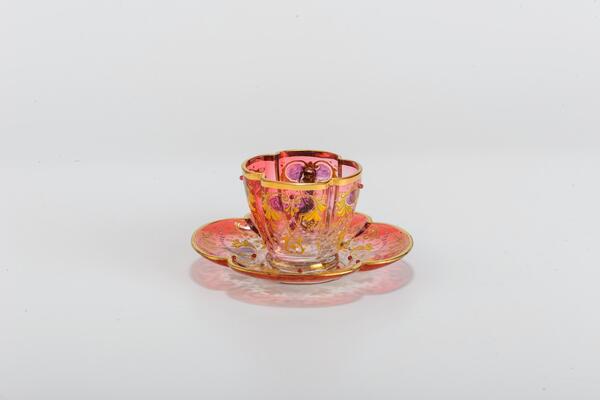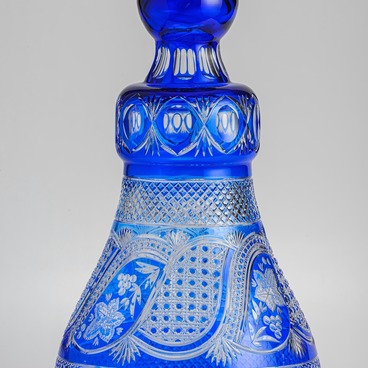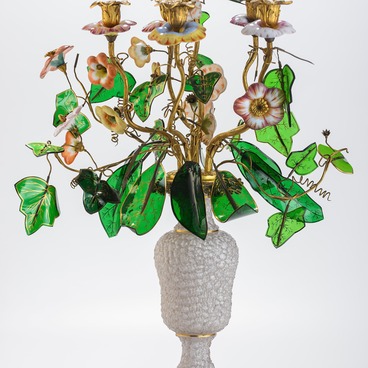The coffee set presented at the exhibition was commissioned by a wealthy nobleman. It displays the elaborate technical skills and artistic taste of its creators.
The cup and saucer were blown from pink glass called “golden ruby”. The design of both items creates a compositional unity: the cup with a thin, elegant handle is shaped into four large convex facets, and an almost flat saucer has four petals. Yellow embossed enamel is used to execute the heart-shaped pattern of thin petals and stylized leaves. The items have a gold trim. The design is distinguished by ruby-pink cabochons fixed in the upper part of the pattern.
Initially, cabochons were precious, semi-precious and ornamental stones polished in a special way. They are distinguished from the facet cut by the absence of facets: the cabochon is made flat on one side and smooth and convex on the other. Later, glass beads that were processed in the same way received the same name. When used for decoration, they resemble precious stones.
Craftsmen used these “stones” to decorate religious objects, products for the eastern market, and even household items.
The products of the Nikolsko-Bakhmetevsky factory have always been of high quality, and in 1836 they were recognized as the best in Russia. The Bakhmetevsky crystal was compared in quality with its English counterpart, and hereditary glass virtuosos were not inferior in skill to European artisans.
During the 19th century, the factory received five gold medals at various exhibitions and fairs. Beginning in the 1800s, artisans carried out important orders for especially noble clients. As the Supplier of the Court of His Imperial Majesty, the factory was granted the privilege to depict the state emblem on a paper stamp.
The owners did not strive to make their factory the largest in Russia, but they cared about the preservation of long-standing traditions and at the same time followed technological and artistic innovations.
By the end of the 19th century, the Nikolsko-Bakhmetevsky factory was headed by Alexander Dmitrievich Obolensky. At the time of his management, the factory became one of the best enterprises in Russia. It could serve as a model for the leading Imperial Glass Factory and other glassmakers who cared not only about commercial benefits, but also about the artistic value of their products, and the opportunity to ensure the glory of Russian glass making.
The cup and saucer were blown from pink glass called “golden ruby”. The design of both items creates a compositional unity: the cup with a thin, elegant handle is shaped into four large convex facets, and an almost flat saucer has four petals. Yellow embossed enamel is used to execute the heart-shaped pattern of thin petals and stylized leaves. The items have a gold trim. The design is distinguished by ruby-pink cabochons fixed in the upper part of the pattern.
Initially, cabochons were precious, semi-precious and ornamental stones polished in a special way. They are distinguished from the facet cut by the absence of facets: the cabochon is made flat on one side and smooth and convex on the other. Later, glass beads that were processed in the same way received the same name. When used for decoration, they resemble precious stones.
Craftsmen used these “stones” to decorate religious objects, products for the eastern market, and even household items.
The products of the Nikolsko-Bakhmetevsky factory have always been of high quality, and in 1836 they were recognized as the best in Russia. The Bakhmetevsky crystal was compared in quality with its English counterpart, and hereditary glass virtuosos were not inferior in skill to European artisans.
During the 19th century, the factory received five gold medals at various exhibitions and fairs. Beginning in the 1800s, artisans carried out important orders for especially noble clients. As the Supplier of the Court of His Imperial Majesty, the factory was granted the privilege to depict the state emblem on a paper stamp.
The owners did not strive to make their factory the largest in Russia, but they cared about the preservation of long-standing traditions and at the same time followed technological and artistic innovations.
By the end of the 19th century, the Nikolsko-Bakhmetevsky factory was headed by Alexander Dmitrievich Obolensky. At the time of his management, the factory became one of the best enterprises in Russia. It could serve as a model for the leading Imperial Glass Factory and other glassmakers who cared not only about commercial benefits, but also about the artistic value of their products, and the opportunity to ensure the glory of Russian glass making.





